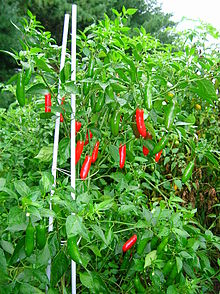| Serrano pepper | |
|---|---|
 Serrano pepper plant with red and green fruits Serrano pepper plant with red and green fruits | |
| Species | Capsicum annuum |
| Origin | Puebla and Hidalgo Mexico |
| Heat | |
| Scoville scale | 10,000–25,000 SHU |
The serrano pepper (Capsicum annuum) is a type of chili pepper that originated in the mountainous regions of the Mexican states of Puebla and Hidalgo. The Scoville rating of the serrano pepper is 10,000 to 25,000. The name of the pepper is a reference to the mountains (sierras) of these regions. The pepper is commonly used to make hot sauces.
Serrano plant

Mature serrano pepper plants reach a height of 0.5–1.5 meters (1 ft 8 in – 4 ft 11 in). Each plant can produce up to 50 pepper berries (not true botanical pods). The fruit can be harvested while they are green or ripe. Unripe serrano peppers are green, but the color varies at maturity; common colors for the ripe fruit are green, red, brown, orange, and yellow. Serrano peppers do better in soils with a pH between 7.0 and 8.5 in warm temperatures above 24 °C (75 °F) and have a low tolerance for frost.
Serrano fruit
| Nutritional value per 100 g (3.5 oz) | |||||||||||||||||||||||||||||||||||||||||||||||||
|---|---|---|---|---|---|---|---|---|---|---|---|---|---|---|---|---|---|---|---|---|---|---|---|---|---|---|---|---|---|---|---|---|---|---|---|---|---|---|---|---|---|---|---|---|---|---|---|---|---|
| Energy | 121 kJ (29 kcal) | ||||||||||||||||||||||||||||||||||||||||||||||||
| Carbohydrates | 6.70 g | ||||||||||||||||||||||||||||||||||||||||||||||||
| Sugars | 3.8 g | ||||||||||||||||||||||||||||||||||||||||||||||||
| Dietary fiber | 3.7 g | ||||||||||||||||||||||||||||||||||||||||||||||||
| Fat | 0.4 g | ||||||||||||||||||||||||||||||||||||||||||||||||
| Protein | 1.7 g | ||||||||||||||||||||||||||||||||||||||||||||||||
| |||||||||||||||||||||||||||||||||||||||||||||||||
| Other constituents | Quantity | ||||||||||||||||||||||||||||||||||||||||||||||||
| Water | 90.25 g | ||||||||||||||||||||||||||||||||||||||||||||||||
| Capsaicin | 0.01g – 6 g | ||||||||||||||||||||||||||||||||||||||||||||||||
| Percentages estimated using US recommendations for adults, except for potassium, which is estimated based on expert recommendation from the National Academies. | |||||||||||||||||||||||||||||||||||||||||||||||||
They are typically eaten raw and have a bright and biting flavor that is notably hotter than the jalapeño pepper. Serrano peppers are also commonly used in making pico de gallo and salsa, as the chili is particularly fleshy compared to others, making it ideal for such dishes.
It is the second most used chili pepper in Mexican cuisine. The Mexican states of Veracruz, Sinaloa, Nayarit, and Tamaulipas produce about 180,000 tonnes of serranos each year.
See also
References
- ^ DeWitt, Dave; Paul W. Boslund (2009). The Complete Chile Pepper Book: A Gardener's Guide to Choosing, Growing, Preserving, and Cooking. Timber Press. p. 64. ISBN 978-0-88192-920-1.
- "Types of hot peppers". Retrieved May 19, 2022.
- Hultquist, Mike (October 18, 2017). "icy Serrano Hot Sauce Recipe". Chili Pepper Madness. Retrieved January 7, 2024.
- Rachiele, Jon (April 12, 2018). "Serrano Hot Sauce". Allrecipes. Retrieved January 7, 2024.
- "Growing Serrano Peppers". PlantDex. Archived from the original on October 19, 2012. Retrieved June 7, 2012.
- United States Food and Drug Administration (2024). "Daily Value on the Nutrition and Supplement Facts Labels". FDA. Archived from the original on March 27, 2024. Retrieved March 28, 2024.
- National Academies of Sciences, Engineering, and Medicine; Health and Medicine Division; Food and Nutrition Board; Committee to Review the Dietary Reference Intakes for Sodium and Potassium (2019). "Chapter 4: Potassium: Dietary Reference Intakes for Adequacy". In Oria, Maria; Harrison, Meghan; Stallings, Virginia A. (eds.). Dietary Reference Intakes for Sodium and Potassium. The National Academies Collection: Reports funded by National Institutes of Health. Washington, DC: National Academies Press (US). pp. 120–121. doi:10.17226/25353. ISBN 978-0-309-48834-1. PMID 30844154. Retrieved December 5, 2024.
- "Serrano Pepper | WorldCrops". worldcrops.org. Retrieved August 17, 2017.
- Nolte, Kurt. "Serrano Peppers" (PDF). cals.arizona.edu. Retrieved August 30, 2012.